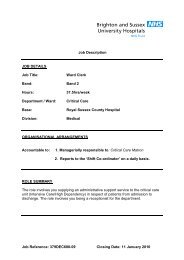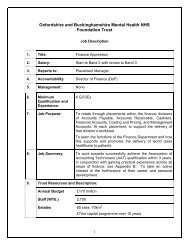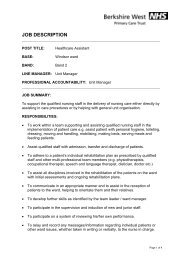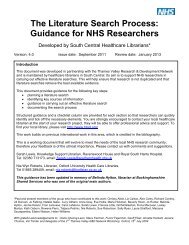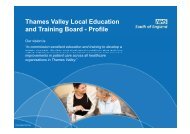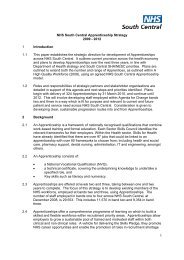Liberating the NHS: Developing the Healthcare Workforce ...
Liberating the NHS: Developing the Healthcare Workforce ...
Liberating the NHS: Developing the Healthcare Workforce ...
Create successful ePaper yourself
Turn your PDF publications into a flip-book with our unique Google optimized e-Paper software.
<strong>Liberating</strong> <strong>the</strong> <strong>NHS</strong>: <strong>Developing</strong> <strong>the</strong> <strong>Healthcare</strong> <strong>Workforce</strong>Response to Consultation1. Executive Summary1.1 Since <strong>the</strong> publication of <strong>the</strong> proposals set out in <strong>Liberating</strong> <strong>the</strong> <strong>NHS</strong>: <strong>Developing</strong> <strong>the</strong><strong>Healthcare</strong> <strong>Workforce</strong> South Central SHA has undertaken wide consultation with<strong>NHS</strong> healthcare providers and o<strong>the</strong>r stakeholders to develop a response to <strong>the</strong>proposals. The SHA has met with over 600 individuals representing all <strong>NHS</strong>organisations across South Central (listed in Appendix 1) culminating in a multiprofessionalconsultation event on 18 February 2011 which was attended by DebbieMellor, Deputy Director of <strong>Workforce</strong> and Education, Department of Health.1.2 There was an overwhelming agreement from healthcare providers for <strong>the</strong> SHA to use<strong>the</strong> consultation information to prepare a response to <strong>the</strong> proposals on <strong>the</strong>ir behalfand a clear mandate for <strong>the</strong> SHA to move forward to develop co-produced options forSouth Central.1.3 The proposals set out <strong>the</strong> new system for developing <strong>the</strong> healthcare workforce andare broadly welcomed, particularly <strong>the</strong> overall vision and high-level objectives whichincludes closer involvement with local authorities. The opportunity to bring health andsocial care education and training toge<strong>the</strong>r is absolutely supported by <strong>the</strong> SHA. Theprinciple that ‘nothing is done at <strong>the</strong> centre that can be done locally’ is at <strong>the</strong> heart ofour response.1.4 In South Central we have always strived for a collaborative approach to workforceplanning, education commissioning and provision and we hope <strong>the</strong> skills networkswould build on <strong>the</strong> expertise and tacit knowledge that exists in <strong>the</strong> current system. Inparticular, engagement and partnership working, quality and innovation, and <strong>the</strong>strategic management of workforce supply and demand have been highlighted by ourstakeholders as particular strengths.1.5 The specific concerns of South Central SHA include <strong>the</strong> need to ensure continuityand that we do not lose organisational skill and experience or <strong>the</strong> goodwill of existingrelationships while developing or delivering <strong>the</strong> new system.1.6 That said, <strong>the</strong> new architecture offers up dramatic possibilities of addressing areas ofweakness and increasing efficiency if done methodically and with appropriate supportduring <strong>the</strong> transition. This includes radical reform of medical workforce planning. Thesimultaneous release of <strong>the</strong> Outcomes Framework (OF) is very timely to enabledesign of workforce and education with <strong>the</strong> OF as a key driver.1.7 For this to be achieved <strong>the</strong>re has to be clarity (and confidence) in <strong>the</strong> structure, rolesand responsibilities between Health Education England (HEE) and skills networksSouth Central Strategic Health Authority – DHW Consultation Response 1
Consultation Questions – Chapter 2Q1: Are <strong>the</strong>se <strong>the</strong> right high-level objectives? If not, why not? Yes, <strong>the</strong>re was wide-spread support for <strong>the</strong>se as high level objectives However, <strong>the</strong>re should be a recognition that it is balancing workforce supply anddemand, not simply ensuring security of supply.Q2: Are <strong>the</strong>se <strong>the</strong> right design principles? If not, why not? Yes, <strong>the</strong>re was wide-spread support for <strong>the</strong>se design principles System alignment needs more integration with service commissioning which is notdescribed in <strong>the</strong> paper in much detail There needs to be careful thought to national/local perspective to ensure functions sitat <strong>the</strong> right level and are driven locally but retaining strategic overview and criticalmass ...“appropriate integration” of public health, local authorities needs a strongermandate to be able implement effectively.Consultation Questions – Chapter 3Q3: In developing <strong>the</strong> new system, what are <strong>the</strong> key strengths of <strong>the</strong> existingarrangements that we need to build on? Strategic overview currently done by <strong>the</strong> SHA Economies of scale for contracting, quality management, knowledge resources The focus on <strong>the</strong> whole of <strong>the</strong> workforce from undergraduate to CPD and Bands1-4 and leadership for all staff at all levels Established and existing networks and relationships Ring-fenced funding and resourcing for workforce development including CPD Continuity of relationships, expertise and tacit knowledge.Q4: What are <strong>the</strong> key opportunities in developing a new approach? Accountability to healthcare providers in all sectors gives better opportunity to alignworkforce, service and financial planning and support complex service redesign To ensure clarity of relationships and strong requirement to build networks with localauthorities, Health and Well-Being Boards, private, voluntary and independent sectorpartners <strong>Workforce</strong> planning and supply across integrated pathways of care Include role and functions of Skills for Health as part of <strong>the</strong> system (from HEE toskills networks) and take <strong>the</strong> opportunity to radically streamline and remove potentialfor duplication Build on current improvements in integrated workforce planning through clarity ofworkforce planning – who will do what at what level – and linking with Monitor andQIPP planning team to ensure streamlining Bring toge<strong>the</strong>r health and social care education and training in order to deliver <strong>the</strong>Outcomes Framework.South Central Strategic Health Authority – DHW Consultation Response 4
Consultation Questions – Chapter 5Q5: Should all healthcare providers have a duty to consult patients, localcommunities, staff and commissioners of services about how <strong>the</strong>y plan to develop<strong>the</strong> healthcare workforce? There needs to be clarity of consultation to ensure harmony, avoid duplication andensure that consultation is for a purpose There needs to be more clarity around <strong>the</strong> term “healthcare provider” as <strong>the</strong>personalisation agenda and Any Willing Provider (AWP) could see mushroom growthin <strong>the</strong> number of “healthcare providers”. Does this include dentistry? (This point ismade again in Q10)– See Q10 for comments on definition of “healthcare provider”The responsibility for strategic consultation and wide scale redesign of complexservices should be at <strong>the</strong> local level e.g. GP consortia engage with localcommunities and share this with healthcare providers and include in commissioningrequirementsProgress in involving patients in <strong>the</strong> education and training of students, traineesand CPD of <strong>the</strong> current workforce should be maintainedLinks with Health and Wellbeing Boards need to be clearer.Q6: Should healthcare providers have a duty to provide data about <strong>the</strong>ir currentworkforce? Yes, though <strong>the</strong> proposals need to better address <strong>the</strong> tension between competitionand collaboration Data collection should be for a clear purpose and <strong>the</strong>re needs to be clarity about <strong>the</strong>definition of healthcare providers GP and community healthcare providers and should be included Is an intention to continue to use ESR to collate this data and if so, what plans are inplace to improve <strong>the</strong> quality of data and extend access to non-<strong>NHS</strong> organisations?Q7: Should healthcare providers have a duty to provide data on <strong>the</strong>ir future workforceneeds? Yes, GP practices, <strong>the</strong> private and voluntary sector including in industries such aspharmacy should be included Increased commercial tension between competition/collaboration and <strong>the</strong>reforecareful management and use of data This is an unknown quantity with AWP where organisations have relied on incentivesto attract healthcare staff and <strong>the</strong>refore <strong>the</strong>re will need to be robust measures forensuring quality of data and rewards/penalties for non-compliance In drawing in private, voluntary and independent sectors to create a managed market<strong>the</strong>re are risks for all organisations, including HEIs, HEE and skills networks need toensure that risk is shared and does not lie solely with <strong>the</strong> <strong>NHS</strong>.Q8: Should healthcare providers have a duty to cooperate on planning <strong>the</strong> healthcareworkforce and planning and providing professional education and training? Yes, especially where economies, efficiencies and equity can be achieved throughco-operation and collaboration and where development costs are high eg eLearning,South Central Strategic Health Authority – DHW Consultation Response 5
There also needs to be reference to co-operation on staff over-supply – <strong>the</strong> focus ison shortages, but oversupply, particularly in terms of parts of <strong>the</strong> medical workforceis likely to be <strong>the</strong> greater issue over <strong>the</strong> next few years.Q12: Are <strong>the</strong>re o<strong>the</strong>r incentives and ways in which we could ensure that <strong>the</strong>re is anappropriate degree of cooperation, coherence and consultation in <strong>the</strong> system? <strong>Workforce</strong> and education outcomes framework to support <strong>the</strong> service outcomesframework, which clearly sets <strong>the</strong> role of workforce and education front and centre toservice delivery A “kite mark” that would be a mark of quality and credibility for AWP benefits ofmembership such as access to <strong>NHS</strong> resources (as mentioned eLearning andknowledge resources) Ensure service commissions include requirements relating to education,development, knowledge and skills as a long term objective Build on and refine current systems.Consultation Questions – Chapter 6Q13: Are <strong>the</strong>se <strong>the</strong> right functions that should be assigned to <strong>the</strong> Health EducationEngland Board? The structure does not go far in enough to radically streamlining <strong>the</strong> whole health andsocial care workforce planning, education and training system. There needs to bemore emphasis on social care within HEE – could this not be Health and Social CareEducation England? Is <strong>the</strong>re merit in exploring whe<strong>the</strong>r <strong>the</strong> National Leadership Council should sit withinHEE – this will ensure a more streamlined link to local delivery of leadership withinskills networks Previous comments stand about including Skills for Health/Care within this system. We would not want to see a separation between <strong>the</strong> workforce work led by HEE and<strong>the</strong> commissioner work led by <strong>the</strong> <strong>NHS</strong> Commissioning Board. <strong>Workforce</strong>development plans will need to be closely linked to policy and strategic planning aswell as embedded in provider responsibilities There are functions that sit nationally at <strong>the</strong> moment that are not specificallymentioned such as national lead on knowledge resources to specific corerequirements and quality standards which should be led by <strong>the</strong> professions throughHEE There needs to be clarity about how HEE will interface with <strong>the</strong> <strong>NHS</strong> CommissioningBoard for dentistry and how <strong>the</strong> Dental Programme Board in turn will interface with<strong>the</strong> National Dental Commissioning Board.Q14: How should <strong>the</strong> accountability framework between healthcare provider skillsnetworks and HEE be developed? Timing for <strong>the</strong> development of accountability frameworks is tight <strong>the</strong>refore earlyidentification of “leads” for skills networks will be essential to negotiate <strong>the</strong> frameworkSouth Central Strategic Health Authority – DHW Consultation Response 7
Two-way accountability needs to be developed. HEE needs to be accountable toskills networks as well as <strong>the</strong> o<strong>the</strong>r way round. For example, in commissioning moreor fewer education and training posts than are <strong>the</strong> aggregate of local plans HEEneeds to provide incentives for local skills networks and take on any riskAccountability frameworks should be broadly <strong>the</strong> same across <strong>the</strong> country but mayneed to allow for differing models of development for skills networks.Q15: How do we ensure <strong>the</strong> right checks and balances throughout all levels of <strong>the</strong>system? Streamlining and clarity of roles throughout <strong>the</strong> whole <strong>NHS</strong> system Strong governance frameworks within skills networks and accountability frameworksbetween HEE, skills networks and clear relationships with CQC and Monitor Ensuring that <strong>the</strong> checks protect <strong>the</strong> operational delivery of education and trainingand that workforce development is not continually interrupted by funding issues Service commissioning needs to increase workforce quality standards throughincluding workforce quality standards within contracts in order to drive providerworkforce development High level of transparency throughout <strong>the</strong> system.Q16: How should <strong>the</strong> governance of HEE be established so that it has <strong>the</strong>confidence of <strong>the</strong> public, professions, healthcare providers, commissioners ofservices and higher education institutions? A voted system for <strong>the</strong> majority of membership TransparencyRepresentation for Skills for Health/Care and o<strong>the</strong>r non-<strong>NHS</strong> stakeholdersComposition should avoid <strong>the</strong> perception of medical dominance recognising <strong>the</strong>breadth of clinical leadership in healthcare.Q17: How do we ensure that <strong>the</strong> Centre for <strong>Workforce</strong> Intelligence is effective inimproving <strong>the</strong> evidence base for workforce planning and supports both localhealthcare providers and HEE? Ensure clarity of role for CfWI and describe in more detail how fixed or flexible Ensure rigorous quality assurance of data and clear relationships and roles betweenCfWI and <strong>the</strong> <strong>NHS</strong> Information Centre Ensure strong links with <strong>the</strong> <strong>NHS</strong> Commissioning Board – service commissioningneeds to drive workforce planning Previous comment on improving data quality of ESR Previous comment on recognising and establishing processes for dealing withcommercial tensions between organisations Strong relationships between CfWI and skills networks, with skills networkscontributing to performance monitoring of CfWI.South Central Strategic Health Authority – DHW Consultation Response 8
Q18: How should we ensure that sector-wide education and training plans areresponsive to <strong>the</strong> strategic commissioning intentions of <strong>the</strong> <strong>NHS</strong> CommissioningBoard? Agree that <strong>NHS</strong> Commissioning Board is represented on HEE for checks andbalances Strongest line should be from <strong>the</strong> <strong>NHS</strong> Commissioning Board to GP commissionersthrough to healthcare providers and skills networks to ensure local responsibility andnot create a tension between top down and bottom up (recognising that may <strong>the</strong>ncreate tension between NCB and GP commissioners)Q19: Who should have responsibility for enforcing <strong>the</strong> duties on providers inrelation to consultation, <strong>the</strong> provision of workforce information, and cooperationin planning <strong>the</strong> workforce and in <strong>the</strong> planning and provision of professionaleducation and training? This responsibility should lie with <strong>the</strong> skills networks as part of self-regulation andmanagement working with CQC, Monitor and CfWI This would mean that <strong>the</strong> skills networks would need to be able to legally implementsanctions and incentives This should follow <strong>the</strong> principle that nothing is done nationally that can be donelocally.Q20: What support should Skills for Health offer healthcare providers duringtransition? Ensure that <strong>the</strong> system supports development of bands 1-4 of <strong>the</strong> workforce (checksand balances) and link to existing work such as <strong>the</strong> National Transferable RolesNetwork Provide advice and guidance for GP consortia and emerging skills networks Continue <strong>the</strong> much valued current tasks and functions throughout <strong>the</strong> transitionperiod.Q21: What is <strong>the</strong> role for a sector skills council in <strong>the</strong> new framework? As has already been suggested, a streamlined system should include <strong>the</strong> work of <strong>the</strong>sectors skills council as fully integrated into HEE and <strong>the</strong> skills network framework Representation at HEE and skills network “boards” Working alongside skills networks to continued role of support to and for providers ofWidening Participation and <strong>the</strong> development of <strong>the</strong> Bands 1-4 workforce includingapprenticeships.Q22: How can <strong>the</strong> healthcare provider skills networks and HEE best secure clinicalleadership locally and nationally? Ensure clinicians are represented locally and nationally and engaged in workforcedevelopment Ensure links between local and national clinicians – preferably through existingstructures such as professional bodies and networks Integrate HEE and NLC for a streamlined system Create whole career approach involving inter-professional leadership at all levels toensure that we develop people able to take on <strong>the</strong>se roles.South Central Strategic Health Authority – DHW Consultation Response 9
Q23: In developing <strong>the</strong> new system, what are <strong>the</strong> responsibilities that need to be inplace for <strong>the</strong> development of leadership and management skills amongstprofessionals? Skills networks need to be responsible for local delivery of leadership andmanagement skills to ensure that <strong>the</strong>se are linked with local service delivery andimprovement This includes building leadership and management skills into all undergraduate, CPDand PGDME education and training programmes Leadership and management skills need to be developed in people at all levels of <strong>the</strong>workforce, not just in professionals Professional bodies and representative organisations should be responsible foradvice, guidance, checks and balances Leadership development needs to retain a strong identity in <strong>the</strong> system throughout<strong>the</strong> transition and beyond.Q24: Should HEE have responsibilities for <strong>the</strong> leadership developmentframework for managers as well as clinicians? Yes, for consistency and cohesion and <strong>the</strong> opportunity for inter professional learningand development aligned to <strong>the</strong> potential National Leadership College to ensurenational delivery of appropriate programmes and local funding Behavioural and business skills which underpin great leadership and managementare <strong>the</strong> same regardless of professional background and treating people differentlyreinforces divisions The <strong>NHS</strong> Management Training Scheme and Gateway initiatives should sit within <strong>the</strong>NLC as part of HEE Leadership and management should be commissioned by skills networks who shouldensure that managers and clinicians learn toge<strong>the</strong>r to facilitate team working.Q25: What are <strong>the</strong> key opportunities for developing clinicians and managers in anintegrated way both across health and social care and across undergraduate andpostgraduate programmes? Inter-professional Learning for all staff groups including medics, clinicians, managersand <strong>the</strong> wider workforce Common core modules (including business and management skills) supported byaction learning sets Education and training programmes developed and delivered across care pathways Fellowships open to all staff groups.Consultation Questions – Chapter 7Q26: How should Public Health England, and its partners in public health delivery, beintegrated within <strong>the</strong> new framework for planning and developing <strong>the</strong> healthcareworkforce? To ensure joined up planning and delivery of <strong>the</strong> public health workforce <strong>the</strong>re needs tobe a close relationship between Public Health England and HEE Public Health England needs representation at Skills Network level in order to workalongside healthcare providers and local authoritiesSouth Central Strategic Health Authority – DHW Consultation Response 10
Responsibility for PH standards and quality assurance of training rests with <strong>the</strong> Facultyof Public Health, Specialty training is currently delivered by <strong>the</strong> Deaneries. PHpractitioner development sits well alongside this under <strong>the</strong> umbrella of <strong>the</strong> deaneryfunction/structure, and should sit within skills networksBecause <strong>the</strong>re is wide variance in health and oral health needs between and within localareas, dental service and workforce and education planning needs to be informed bysound dental public health advice at both local and national levels.Q27: Should Local Authorities become members of <strong>the</strong> healthcare provider skillsnetwork arrangements, including <strong>the</strong>ir associated responsibilities; and whatfunding mechanisms should be employed with regard to <strong>the</strong> public healthworkforce? Yes, local authorities should be members of healthcare provider skills networks toensure greater collaboration regarding training, education and developing <strong>the</strong> publichealth workforce and embedding public health in all local workforce developmentstrategies Central funding (as happens now through MPET) through Public Health England wouldprovide a straightforward accountable system to oversee <strong>the</strong> quality of speciality trainingprovision in public health as more players come into <strong>the</strong> field There needs greater recognition in any proposals that much of <strong>the</strong> delivery of healthpromotion is at sub-specialist level and greater thought to <strong>the</strong> development of <strong>the</strong> multisectorpublic health workforce in a strategic, coherent and structured way.Consultation Questions – Chapter 8Q28: What are <strong>the</strong> key issues that need to be addressed to enable a strategic,provider-led and multi-professional approach to funding education and training,which drives excellence, equity and value for money? Joined up inter-professional thinking from <strong>the</strong> start - ensure that HEE and skillsnetworks address <strong>the</strong> needs of <strong>the</strong> whole workforce at all levels and all sectorsincluding primary care, LA and PVI, and <strong>the</strong> Dental Programme Board whichaddresses dental multi-professional workforce issues Maintaining <strong>the</strong> long-term vision of workforce development whilst remaining flexible Ensure compatibility of strategic overview from HEE with a local provide-ledapproach Systems and processes to ensure quality metrics are set, implemented, monitoredand auctioned Ensure that skills networks and HEE are able to implement incentives or punitivemeasures with skills networks self-managed and HEE providing a strategic overviewand ensuring that actions of skills networks are fair and do not disadvantage o<strong>the</strong>rnetworks. Eg by deciding not to train a particular staff group and divert funding toincrease employment premiums Addressing <strong>the</strong> lack of national and systematic planning of <strong>the</strong> dental workforcealongside dental service commissioning, this has hampered <strong>the</strong> introduction oftraining programmes, skill mix and appropriate role substitution Work to outcomes ra<strong>the</strong>r than inputs.South Central Strategic Health Authority – DHW Consultation Response 11
Q29: What should be <strong>the</strong> scope for central investment through <strong>the</strong> Multi-Professional Education and Training budget? Firstly, need clarity around <strong>the</strong> terms “next generation of clinical staff” eg does thisinclude trainee doctors, or are <strong>the</strong>se people part of <strong>the</strong> current workforce engaged inservice delivery Initiatives that contribute towards a managed workforce market Commissioning and development of smaller professional groups National policy initiatives, eg current increase in health visitors must be fundednationally or left to local providers to determine need There is a case for central investment in areas which underpin education andworkforce development to deliver best value for money and avoid duplication Need to ensure close working with HEIs as many education providers are currentlyreviewing <strong>the</strong>ir own programmes and as a result <strong>the</strong>re may be cases for joined upapproaches by Skills Network or direct central investment.Q30: How can we ensure funding streams do not act as a disincentive to innovationand are able to support changes in skill mix? Ring- fenced funding for education and training, but flexibility within that Funding streams for care pathways with local skills networks to determine <strong>the</strong> skillsgaps along those pathways Remit for skills networks to deliver innovation in workforce and education and build<strong>the</strong> evidence-base Longer-term commitment to funding – at least three years or fund commissionoutcomes ra<strong>the</strong>r than inputs.Q31: How can we manage <strong>the</strong> transition to tariffs for clinical education and training ina way that provides stability, is fair and minimises <strong>the</strong> risks to providers? Retain <strong>the</strong> current MPET funding streams for two to three years to fund <strong>the</strong> newarrangements and ensure focus on delivery of healthcare workforce development Transition to tariffs to be assessed alongside <strong>the</strong> impact of o<strong>the</strong>r changes in financeand not in isolation in order to determine <strong>the</strong> issues and plan transition Long lead times have been previously discussed – phased in over four years Too much change too soon will seriously destabilise large providers with minimalbenefit to organisations set to gain. Let <strong>the</strong> new systems bed in before fur<strong>the</strong>r change Clarity needed around <strong>the</strong> negotiation of <strong>the</strong> benchmark price and how HEE will beperformance managed to undertake this task This must apply to all sectors.Q32: If tariffs are introduced, should <strong>the</strong> determination of <strong>the</strong> costs and tariffs foreducation and training be part of <strong>the</strong> same framework as service tariffs? Possibly, but need to know if <strong>the</strong>re is a presumed element of education and trainingin service tariffs already in existence Education and training tariffs should be clearly set out separately from service tariffsand would <strong>the</strong>n need to include recognition of education and training <strong>the</strong> wholeworkforce.South Central Strategic Health Authority – DHW Consultation Response 12
Q33: Are <strong>the</strong>re alternative ways to determine <strong>the</strong> education and training tariffso<strong>the</strong>r than based on <strong>the</strong> average national cost? Average national cost adjusted by regional market forces factors seems reasonable.The concern is how <strong>the</strong> average national cost is calculated.Q34: Are <strong>the</strong>re alternative ways to determine <strong>the</strong>se costs o<strong>the</strong>r than by a detailedbottom-up costing exercise? None that would gain <strong>the</strong> confidence of <strong>the</strong> large teaching trusts set to “lose”.Q35: What is <strong>the</strong> appropriate pace to progress a levy? Following consultation and preparatory work, plus a review of <strong>the</strong> impact of allfinancial changes on providers, implementation should be relatively swift Currently top-slicing MPET contributes to strategic reserves for <strong>the</strong> SHA which ispassed back to trusts – this funding flow would need to be taken into account inassessing <strong>the</strong> pace.Q36: Which organisations should be covered by <strong>the</strong> levy? Should it includehealthcare providers that do not provide services to <strong>the</strong> <strong>NHS</strong> but deliver <strong>the</strong>ir servicesusing staff trained by <strong>the</strong> public purse? Morally, this is a fair change to make. However need to clarify “healthcare provider”and ensure that <strong>the</strong> administrative process does not outweigh <strong>the</strong> benefits A different system could pose a levy to students who choose <strong>the</strong>n to work outside <strong>the</strong><strong>NHS</strong>. The impact on recruitment would need to be assessed, but is in line withnational changes to charge students for university fees.Q37: How should a levy be structured so that it gives <strong>the</strong> right incentives forinvestment in education and training in <strong>the</strong> public interest? Ensure that <strong>the</strong> level of funding provided via MPET is not diminished Ensure that <strong>the</strong>re are no loops in <strong>the</strong> system e.g. employment of qualified staff whotrained outside <strong>the</strong> <strong>NHS</strong> Work alongside professional bodies and monitoring bodies to set high minimumclinical quality standards to ensure that a levy does not encourage organisations tointroduce skill mixes of team that are too low and jeopardise quality of care.Q38: How can we introduce greater transparency in <strong>the</strong> short to medium term? Greater engagement of <strong>the</strong> private, voluntary and independent sectors in skillsnetworks and HEE Transparency of <strong>the</strong> consultation and preparatory work for levies which would needto include financial projections and detailed negotiations Ensure involvement of staff representative bodes Clarity over legitimate running costs for skills networks.South Central Strategic Health Authority – DHW Consultation Response 13
Q39: How can transaction costs of <strong>the</strong> new system be minimised? National negotiation and agreed rates Transactions through shared services DH to ensure sufficient resource in <strong>the</strong> system to ensure delivery by 2012.Q40: What are <strong>the</strong> key quality metrics for education and training? A workforce able to meet <strong>the</strong> clinical outcomes framework KPIs to reflect improved clinical and pathway measures relating to QIPP Inter professional learning at appropriate levels and <strong>the</strong> development of team workingwhich is known to promote quality care Leadership and management skills delivered through all education and training Access to learning through a variety of methods that support learning styles, needsand preferences Access to knowledge resources to support patient care, management,commissioning, education, research, and <strong>the</strong> skills to use and apply knowledgeresources Oracle Learning Management (OLM) needs to be ei<strong>the</strong>r upgraded significantly or <strong>the</strong>Department of Health needs to review its decision to promote a single system thatmay not deliver significant functionality to enable skills networks to succeed.Consultation Questions – Chapter 9Q41: What are <strong>the</strong> challenges of transition? Extremely tight timescales for an extensive change programme, <strong>the</strong>re may be a needfor interim structures Ensure that we don’t lose <strong>the</strong> ethos of education and through “prices” on <strong>the</strong> heads ofstudents and trainees Ensure that funding continues to flow – blockages, or perception of blockages, willhave a detrimental effect Funding <strong>the</strong> costs of change while ensuring essential business Protect individual professional and non-professional groups while developing interprofessionalworking Ensure that workforce and education continues to link in to <strong>the</strong> national picture and<strong>the</strong> wider emerging changes for <strong>the</strong> <strong>NHS</strong> Current use of MPET in strategic reserves to support trusts in financial difficulty With SHAs are due to dissolve in 2012 and <strong>the</strong> National Dental CommissioningBoard not expected to be functional before 2013, interim arrangements may beneeded to ensure continuity of supply of a trained dental workforce.Q42: What impact will <strong>the</strong> proposals have on staff who work in <strong>the</strong> current system? Need to work to maintain staff in <strong>the</strong> current system to ensure capacity and capabilityfor transition A well designed system will give all staff who work in <strong>the</strong> current system a clear lineof sight between <strong>the</strong>ir job role and patient outcomes Staff working in all aspects of <strong>the</strong> system including education and trainingdepartments in trusts, Skills for Health, local authorities need additional time andsupport to reflect on and contribute to <strong>the</strong> proposals There is <strong>the</strong> challenge of reduced productivity during <strong>the</strong> transition, particularly forstaff working in SHAs and PCTs.South Central Strategic Health Authority – DHW Consultation Response 14
Q43: What support systems might <strong>the</strong>y need? Effective communication Time and support from a variety of sources: HR, line management Incentives, rewards and motivations Systems to build capacity and capability for <strong>the</strong> structures.Q44: What support should <strong>the</strong> Centre for <strong>Workforce</strong> Intelligence provide to enable asmooth transition? Work with SHAs to build capacity and capability in healthcare provider organisationsincluding <strong>the</strong> private, voluntary and independent sectors Consult on and publish plan to improve data quality Clarify working relationships between CfWI and <strong>the</strong> <strong>NHS</strong> Information Centre.Consultation Questions – Chapter 10Q45: Will <strong>the</strong>se proposals meet <strong>the</strong>se aims and enable <strong>the</strong> development of a morediverse workforce? The proposals need more commitment and clarity to Bands 1-4, CPD, innovationand leadership development to build a more diverse workforce More commitment at all levels for BME staff to progress into leadership roleswhich are in danger of being lost if leadership loses its strong identity The proposals need to ensure that talent pipelines are taken into <strong>the</strong> newsystems.Q46: Do you think any groups or individuals (including those of different age, ethnicgroups, sexual orientation, gender, gender identity (including transgender people),religions or belief; pregnant women, people who are married or in a civil partnership,or disabled people) will be advantaged or disadvantaged by <strong>the</strong>se proposals or havegreater difficulties than o<strong>the</strong>rs in taking part in <strong>the</strong>m? If so, what should be done toaddress <strong>the</strong>se difficulties to remove <strong>the</strong> disadvantage?The general lack of clarity and commitment to Bands 1-4 of <strong>the</strong> workforce couldaffect groups in that part of <strong>the</strong> workforce which is mainly made up of womenThe introduction of levies as answered in question 36 could introduce advantages ordisadvantages to groups of workers and/or students/traineesAll proposals should be considered from <strong>the</strong> viewpoint of all groups and individuals inorder to assess <strong>the</strong>se issuesAgain, <strong>the</strong>re needs to be more emphasis on leadership and <strong>the</strong> positive contributionof initiatives such as BME Breaking Through and regional inclusion programmesBME staff have <strong>the</strong> potential to be more disadvantaged through transition asevidenced in <strong>the</strong> <strong>NHS</strong> Institute for Innovation and Improvement Report, 2009, Accessof BME Staff to Senior Positions in <strong>the</strong> <strong>NHS</strong>.South Central Strategic Health Authority – DHW Consultation Response 15
Appendix 1:Organisations who contributed to this response:Basingstoke and North Hampshire <strong>NHS</strong> FTWinchester & Eastleigh <strong>Healthcare</strong> <strong>NHS</strong> TrustBerkshire East PCTBerkshire West PCTBerkshire <strong>Healthcare</strong> <strong>NHS</strong> FTCoventry UniversityBuckinghamshire New UniversityBritish Medical AssociationBournemouth UniversityThe Royal Bournemouth and Christchurch Hospitals <strong>NHS</strong> Foundation TrustBuckinghamshire <strong>Healthcare</strong> <strong>NHS</strong> TrustEastleigh North/Test Valley South GP Locality GroupDorset HealthCare University <strong>NHS</strong> FTDorset County Hospital <strong>NHS</strong> FTHampshire Partnership <strong>NHS</strong> Foundation TrustHampshire Community <strong>Healthcare</strong>Hea<strong>the</strong>rwood & Wexham Park Hospital <strong>NHS</strong> TrustMilton Keynes Hospital <strong>NHS</strong> Foundation Trust<strong>NHS</strong> Buckinghamshire<strong>NHS</strong> Hampshire<strong>NHS</strong> Isle of Wight<strong>NHS</strong> Milton Keynes<strong>NHS</strong> Southampton CityNuffield Orthopaedic Centre <strong>NHS</strong> TrustOxford Brookes UniversityOxford Deanery Medical EducatorsOxford Health <strong>NHS</strong> FT (previously Oxford and Bucks Mental Health <strong>NHS</strong> FT)Oxford Radcliffe Hospitals <strong>NHS</strong> TrustOxfordshire PCTPoole Hospital <strong>NHS</strong> FTPortsmouth City CouncilPortsmouth Hospitals <strong>NHS</strong> TrustRidgeway Partnership (Oxfordshire Learning Disability <strong>NHS</strong> TrustRoyal Berkshire <strong>NHS</strong> Foundation TrustSalisbury <strong>NHS</strong> Foundation TrustSkills for HealthSociety of RadiographersSolent <strong>Healthcare</strong> (Solent <strong>NHS</strong> Trust from 1 April)South Central Ambulance <strong>NHS</strong> TrustSouthampton Independent Treatment Centre Care UKSouthampton University Hospitals <strong>NHS</strong> TrustThames Valley HIECThames Valley UniversityThe Open UniversityUniversity College London Eastman Dental InstituteUniversity of BedfordshireUniversity of NorthamptonUniversity of OxfordUniversity of PortsmouthUniversity of ReadingUniversity of SouthamptonSouth Central Strategic Health Authority – DHW Consultation Response 16
University of SurreyUniversity of WinchesterWessex Deanery Medical EducatorsWessex HIECThe SHA met with stakeholders at <strong>the</strong> following events<strong>Developing</strong> <strong>the</strong> <strong>Healthcare</strong> <strong>Workforce</strong>: A Consultation on Proposals, 18 February 2011Service and Education Partnership Meeting, 25 January 2011Chief Executives’ ForumHR Directors’ ForumMedical Directors’ ForumDirectors of Nursing ForumAHP Leads Meeting<strong>Workforce</strong> Planners MeetingOxford Deanery Medical Educators Annual ConferenceWessex Deanery Medical Educators Annual ConferenceThames Valley HIEC MeetingAnd at:Individual meetings with <strong>NHS</strong> organisationsPeter LeesMedical Director/Director of <strong>Workforce</strong>, Education and LeadershipSouth Central Strategic Health AuthorityContact:Caroline Crabtree, Communications and Engagement ManagerCaroline.crabtree@nesc.nhs.uk01962 718548www.workforce.southcentral.nhs.ukSouth Central Strategic Health Authority – DHW Consultation Response 17






